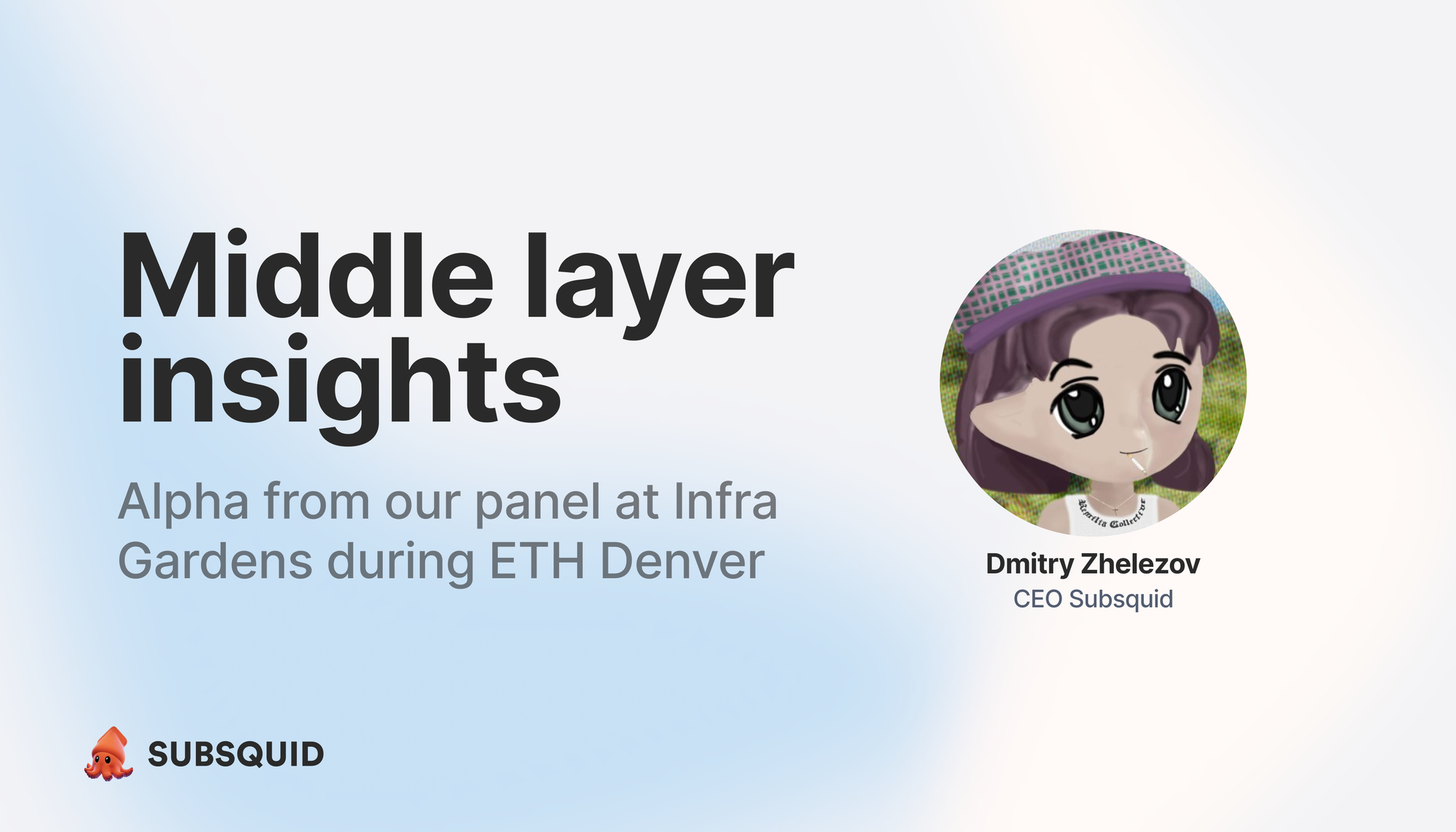Middle layer insights

During Infra Gardens, an event we co-hosted with countless other exciting blockchain projects in Denver, our CEO, Dmitry Zhelezov, spoke on a panel discussing interoperability from an infra and middle layer perspective.
Also on the panel were speakers from DIA, Coinfund, and LiFi Protocol. You can watch the recording here.
🎙Panel 3 | Moderated by @DIAdata_org
— idOS (@idOS_network) March 13, 2024
Topic: Interoperability from an infra and middle layer perspective
Speakers:
▸ @pclaudius | @DIAdata_org
▸ @jbrukh from @coinfund_io
▸ @DominikHell6 | @lifiprotocol
▸ @dizhel | @subsquid pic.twitter.com/KJWc2wKLfN
In this post, we’re summarizing some of the key points made about infrastructure and shedding further insights on why Subsquid operates the way it does.
On the thesis behind Subsquid
One key reason Subsquid was built was to facilitate the extraction of data at scale. Dmitry pointed out that even though we scaled all aspects of blockchain, from blockspace to storage options, the data access layer has been somewhat neglected.
RPC nodes are not built to serve terabytes of data. Subsquid is. Using Subsquid, builders can easily index EVM and Substrate chains (soon Solana) without needing to access archive nodes. Subsquid is for experienced devs that know what they want, and need maximum flexibility. Therefore, we’ve specialized in making data available as it is without being opinionated.
On how far we are in adoption
While this might be a fairly philosophical question, crypto adoption generally happens in waves. And in terms of infrastructure, breakthrough projects always tend to build at the edge of what’s possible with the existing infrastructure.
This means they aren’t building final products but pushing the limits of the currently limited infrastructure. This process mirrors how breakthrough products have been built in Web2, where YouTube was a barely possible product until capacities scaled up to deliver streams across the world seamlessly.
Even though there is plenty of cheap block space with the advent of L2s and alternative L1s, solving for different issues - another challenge hindering products that bridge the gap is the friction to move beyond chains.
Often, the infra does not scale with chain expansion, fragmenting user base, and liquidity. Still, the speakers are optimistic that we’re slowly moving to a world where use cases beyond just DeFi are possible. Take Farcaster, which has chosen to take a pragmatic approach to enable its social protocol by storing much of the data in a network of hubs instead of onchain. For end-users, all the data is still aggregated and shown in one interface.
The existence of such apps then highlights the need for another key ingredient to facilitate future adoption of non-DeFi apps: a data layer connecting chains to allow for aggregation, multichain expansion, and bridging between off- and onchain actions.
We’re still somewhat early.
On the Multichain world
All panelists agreed that the world is multichain and we’ll have many blockchains, maybe even thousands. Nevertheless, it’s also quite obvious that among those are countless zombie chains that generate terabytes of data without much value generation for users.
Some of the speakers position L2s and L3s as the potential end-game, and with the recent Dencun upgrade, operating rollups using Ethereum DA has become more affordable. However, developers still face challenges if they want to guarantee compatibility at the app layer: They need to have composability at the data layer and aggregate state across rollups. This underpins the need for decentralized middleware that can facilitate this in a Web3 way.
On Indexing
As an indexing protocol, Subsquid is often compared with the graph. As our CEO mentions, the Graph was a great solution in 2020 when most dApps were simple DeFi apps built in the EVM ecosystem. Behind the Graph’s architecture are a few assumptions, including that the node that one connects with will always provide correct data.
With the increase in blockchains, this assumption doesn’t hold up anymore. Take Solana, which generates terabytes of data without a straightforward way to access it. And there are numerous smaller chains where one can’t even verify the block hash.
What’s more, by relying entirely on RPC nodes to deliver data, we break the notion of trustlessness. That’s why Subsquid adopted a model that doesn’t rely on RPC nodes but on data providers that offer high-quality, refined data in permanent storage with a hash, allowing devs to easily query and work with it.
For more on how Subsquid operates, check out our docs.
And if you’re a chain looking to have your data added to our data lake to power devs with lightning-fast access to on-chain data, get in touch.